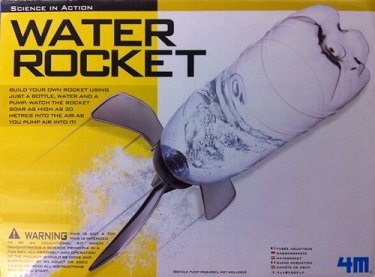Water Rocket

A water rocket uses air pressure combined with water to launch high into the air. The rocket is partially filled with water and then pressurized with air. The air is pumped into the rocket from the bottom. As the air is pumped in it floats through the water and into the empty space above the water. The space above the water then becomes pressurized, and stores energy, much like a spring stores energy when you compress it. Once the air pressure becomes high enough the rocket releases from its launch base, and the water shoots out of the rocket base and causes the rocket to fly straight up at high speed.
Check out a video of a water rocket:
The pressurized air inside the rocket provides a means to store energy. The water provides the ejection mass necessary to create the force needed to launch the rocket at high speed. At the instant the rocket launches, the pressurized air begins to push the water out of the bottom opening of the rocket. As this happens, a “push” force is exerted back on the rocket in the opposite direction (upwards). This can be explained by Newton's third law, which states that for every action force there is an equal and opposite reaction force. As the water exits the rocket in the downward direction it experiences a push force also acting in the downward direction. But the rocket experiences this same force, in the opposite (upward) direction. And this push force is what makes the rocket travel straight up into the air at a high speed.
Typically, a water rocket uses a plastic bottle in which the pressurized air, and water, goes in. When the air pressure becomes high enough, the plastic bottle releases and flies high up into the air.
The higher the air pressure, the faster the water shoots out, and the greater the “push” force on the rocket. As a result, the rocket launches into the air faster. This in turn means the rocket will travel higher in the air.
The fins that go on the bottom of the rocket are there to stabilize the rocket during flight and keep the rocket flying straight. Without these fins the rocket would turn end over end in the air due to the forces caused by air resistance. As a result, the rocket would not travel nearly as far. The fins on the rocket are similar to the fletchings on arrows. The fletchings “catch” the wind as the arrow flies and help it to fly straight.
If you want to see a really cool homemade large-scale water rocket check out this video:
Return to Science Toys page
Return to Real World Physics Problems home page
Free Newsletter
Subscribe to my free newsletter below. In it I explore physics ideas that seem like science fiction but could become reality in the distant future. I develop these ideas with the help of AI. I will send it out a few times a month.